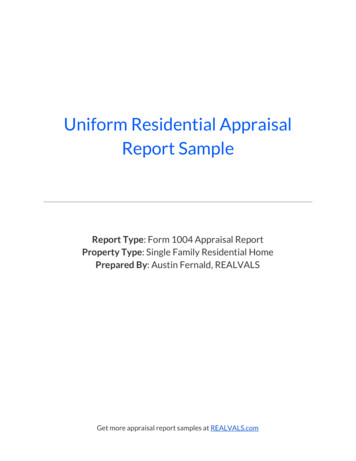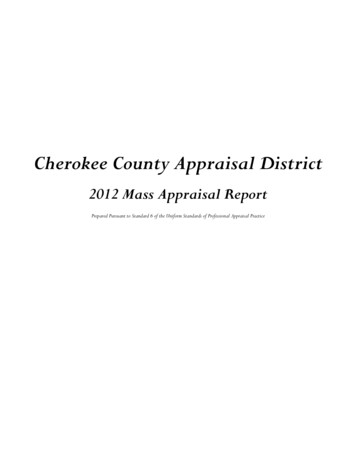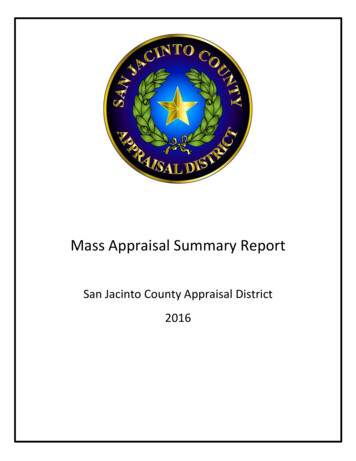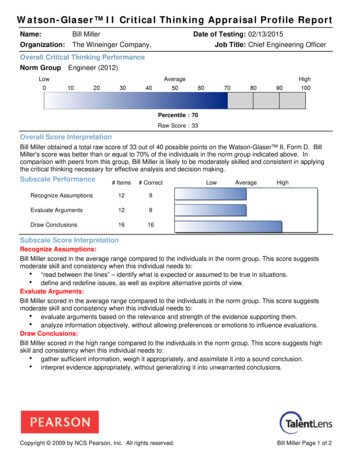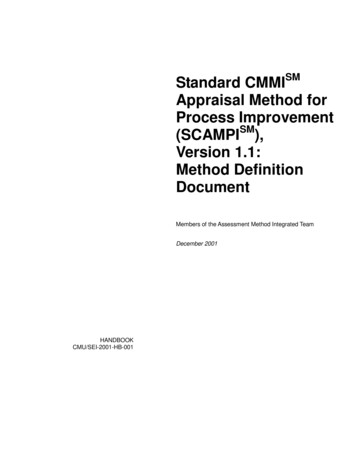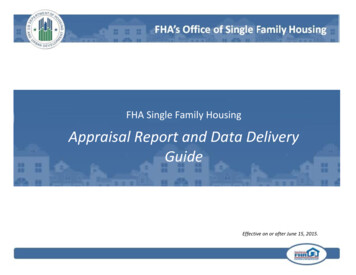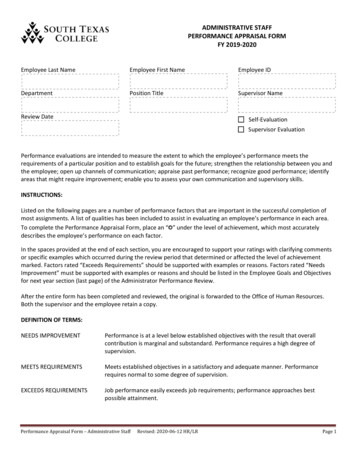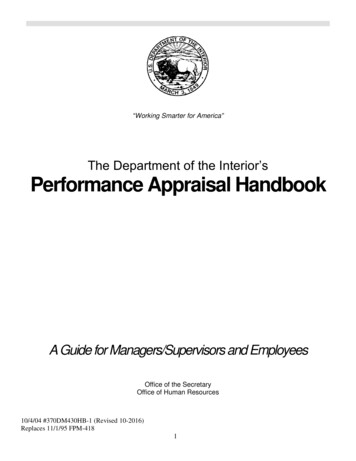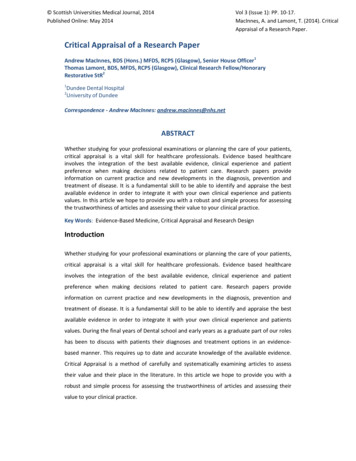
Transcription
Scottish Universities Medical Journal, 2014Published Online: May 2014Vol 3 (Issue 1): PP. 10-17.MacInnes, A. and Lamont, T. (2014). CriticalAppraisal of a Research Paper.Critical Appraisal of a Research PaperAndrew MacInnes, BDS (Hons.) MFDS, RCPS (Glasgow), Senior House Officer1Thomas Lamont, BDS, MFDS, RCPS (Glasgow), Clinical Research Fellow/HonoraryRestorative StR212Dundee Dental HospitalUniversity of DundeeCorrespondence - Andrew MacInnes: andrew.macinnes@nhs.netABSTRACTWhether studying for your professional examinations or planning the care of your patients,critical appraisal is a vital skill for healthcare professionals. Evidence based healthcareinvolves the integration of the best available evidence, clinical experience and patientpreference when making decisions related to patient care. Research papers provideinformation on current practice and new developments in the diagnosis, prevention andtreatment of disease. It is a fundamental skill to be able to identify and appraise the bestavailable evidence in order to integrate it with your own clinical experience and patientsvalues. In this article we hope to provide you with a robust and simple process for assessingthe trustworthiness of articles and assessing their value to your clinical practice.Key Words: Evidence-Based Medicine, Critical Appraisal and Research DesignIntroductionWhether studying for your professional examinations or planning the care of your patients,critical appraisal is a vital skill for healthcare professionals. Evidence based healthcareinvolves the integration of the best available evidence, clinical experience and patientpreference when making decisions related to patient care. Research papers provideinformation on current practice and new developments in the diagnosis, prevention andtreatment of disease. It is a fundamental skill to be able to identify and appraise the bestavailable evidence in order to integrate it with your own clinical experience and patientsvalues. During the final years of Dental school and early years as a graduate part of our roleshas been to discuss with patients their diagnoses and treatment options in an evidencebased manner. This requires up to date and accurate knowledge of the available evidence.Critical Appraisal is a method of carefully and systematically examining articles to assesstheir value and their place in the literature. In this article we hope to provide you with arobust and simple process for assessing the trustworthiness of articles and assessing theirvalue to your clinical practice.
BackgroundOnce an article is identified, critical appraisal involves a structured approach to examiningevidence to assess its value and clinical relevance to modern practice. This allowspractitioners to recognise studies which are biased or poorly designed and therefore ensureonly the most reliable information is incorporated into clinical practice. As the medicalprofession evolves, undergraduate and junior practitioners are increasingly expected to beaware of current developments in patient care.care Figure 1 outlines the three importantcomponents in providing evidence based hcareClinicalExpericancePatientPreferenceFigure 1:Providing evidenced based healthcare – three important componentsAn important part of the process is an understanding of the differing levels of the evidencehierarchy. Figure 2, below, highlights the differing study designs and their relativerobustness and reliability. Evidence from meta-analysismeta analysis of randomised control trials, such assystematic reviews carried out by the Cochrane Collaboration, are considered to be the goldstandard in evidence. These involve the aggregation of the highest quality studies availablewith careful appraisal and statistical analysis of the findings. These, in turn, may form the
basis for evidence based clinical practice guidelines that serve to aid the translation of bestavailable evidence into clinical practice2. Due to the nature of these studies and theprerequisite body of evidence needed, in many areas of healthcare these are not availableand alternate study designss are utilised.IaIbIIaIIbIIIIV Evidence from meta-analysisanalysis of RCTs EvidenceEvidence from at least one RCT EvidenceEvidence from at least one well designed, controlled trial which isnot randomised EvidenceEvidence from at least one well designed experimental trial EvidenceEvidence from case, correlation and comparitive studies EvidenceEvidence from a panel of expertsFigure 2:Levels of EvidenceAlthough assessment of the level of evidence is a significant aspect of critical appraisal, it isessential to note that studies utilising designs recognised as one of the lower levels ofevidence may still have a value to the profession and increase the body of evidenceavailable, e.g. case, correlation or comparative studies may be a precursor to assess ahypothesis before a randomised control trial can be designed. Therefore, different criticalappraisal toolsools may be utilised to assess the varying study designs available. Additionally,some study questions may preclude themselves to a particular study design2, i.e. a doubleblind, randomised control trial of parachutes may not be appropriate! Figure 3 demonstratesdemonthe most appropriate study design to answer the different type of questions being asked.
Therapy Randomised controlled trialPrevention Randomised controlled trialAetiology Randomised controlled trialHarm Randomised controlled trialPrognosis Cohort Study with 80% follow-upDiagnosis ValidatingValidating cohort study with good reference standardsDifferential Diagnosis Prospective cohort study with adequate follow-upupSymptom PrevalenceStudy Prospective cohort study with adequate follow-upupFigure 3:Research design for different clinical questionsCarrying out Critical AppraisalCritical appraisal may be carried out utilising various assessmeassessmentnt tools. These involve theevaluation of different aspects of the paper and, in turn, highlight important characteristicsof the paper and study design used. A useful resource to aid the assessment of the multiplestudy designs employed is the critical skskills assessment programme (CASP)Critical Skills Appraisal Programme (CASP)Founded in 1993 the CASP program is a nonnon-profitprofit entity that provides resources, learningand development opportunities to support critical appraisal skills development in the UK1. Itprovides critical appraisal checklists for different types of study designs to enablecomprehensive and robust protocols for critically appraising a research paper. This sectionbreaks critical appraisal down to assess 7 main points of a research paper.paper. Similar to theCASP methodology we will assess the important features of any research paper and highlightkey points that should be evaluated.
Initial AssessmentThe initial assessment of a research paper involves a generalised look at the details of thearticle and the publication it is appearing in. It may be of value to look at the year the articlewas published in and ascertain if new evidence has been added to the literature since thispublication. Conversely, it is also important to note that seminal papers may have beenpublished a significant time ago and, although the studies are old, these may still be ofsignificance to modern practice.The presence of a peer review process in journal acceptance protocols also adds robustnessto the assessment criteria for research papers and hence would indicate a reducedlikelihood of publication of poor quality research. Other areas to consider may includeauthors’ declarations of interest and potential market bias.ProblemAppraisal of the paper hypothesis and problem addressed by the study is a crucial facet ofcritical appraisal. For a study to have value it must address a significant or relevant problemwithin healthcare and usually provide new or meaningful results. A useful structure forassessing the problem addressed in the article is the Problem Intervention ComparisonOutcome (PICO) method. This involves identifying if the research has a focused question(problem), appropriate and clearly stated management strategy (intervention), a suitablecontrol or alternative (comparison) and that the desired results or patient relatedconsequences have been identified (outcomes). The current literature should have beenreviewed and commonly will support the hypothesis, which should be clearly stated.MethodologyThe study design of the research is fundamental to the usefulness of the study. Several typesof study design, noted in Figure 4, are available and each has their advantages anddisadvantages. Suboptimal study design can incorporate bias into the study andsubsequently skew results.Assessment of the data collection tool and its relevance to the problem is important, i.e. ifthe problem involved assessment or measurement of a disease is the method of doing thisappropriately specific and sensitive. The data collection of a study should be objective andthe results reproducible. Additionally, it is important to consider if the amount of time
allocated for data collection was appropriate and relatable to the clinical course of thedisease or interventionrvention being studied.Study DesignsDescriptive- Cross sectional- Case report- Case series- SurveyAnalyticalObservational- Case Control- Cohort StudiesExperimental- Randomisedcontrol trialFigure 4:Different Study DesignsParticipants/Sample PopulationAnalysis of the sample population utilised in the research will give an indication as to therelevance of the study results to individual clinical practice. To minimise any bias within astudy the sample population should be representative of the populationpopulation being studied as awhole and, ideally, participants should be allocated randomly within the study. It is alsoimperative to consider the sample size in the study and identify if the study is adequatelypowered to produce statistically significant resultsresults, i.e. p values quoted are 0.05.Data Analysis and ResultsThe results of the study should be presented in a suitable manner with the main result,whether it supports or opposes the paper hypothesis, clearly demonstrated. The use ofcharts and graphs shoulduld highlight the data collected and facilitate analysis of the outcomes.Correct statistical analysis of results is crucial to the reliability of the conclusions drawn fromthe research paper. Depending on the study design and sample selection method empemployed,observational or inferential statistical analysis may be carried out on the results of the study.It is important to identify if this is appropriate for the study.Conclusion of PaperAnalysis of the conclusions drawn from the study involves assessmentassessment of the author’sinterpretation of the results and an overall general assessment of study outcome. When
critically appraising the conclusions of a study it is vital to consider if the results are preciseenough to infer a conclusion and also whether the data was shown to be statisticallysignificant, i.e. p value 0.05.Appraisal of the conclusions should also ensure recommendations stated were appropriatefor the results achieved and also within the scope of the study. The authors should alsoaddress shortcomings in the study and discuss how this may have affected the results andrecommendations proposed.Overall AssessmentAfter careful analysis of the different aspects of the research paper the final stage ofcritically appraising a research paper is assessing the relevance of its findings to theprofession. The reported outcomes of the diagnostic, preventative or treatmentintervention should be assessed focusing on the balance of potential benefits and drawbackswhen compared to accepted alternatives.SummaryIn conclusion, critical appraisal is a fundamental skill in modern practice for assessing thevalue of research papers and providing an indication of their relevance to the profession. Asthe medical profession evolves and studies providing information on the diagnosis,prevention and treatment of diseases are published it is crucial to be able to discern the bestavailable evidence. Practitioners are then able to, through systematic reviews or guidelines,synthesise the available evidence in order to identify if a change in practice is indicated.Critical appraisal is a skills-set developed throughout a professional career that facilitatesthis and, through integration with clinical experience and patient preference, permits thepractice of evidence based medicine and dentistry.
References1Critical Appraisal Skills Programme, About CASP, http://www.casp-uk.net/about-casp/2Richards, D., et al. (2008). Evidence-Based Dentistry: Managing Information for BetterPractice, Quintessence Publishing Company, Incorporated.3Centre For Evidence Based Dentistry, http://www.cebd.org/4David L Sackett, William M C Rosenberg, J A Muir Gray, R Brian Haynes, and W ScottRichardson. Evidence based medicine: what it is and what it isn’t. BMJ 1996; 312: 71-725Richards, D. and Lawrence, A. Evidence-based dentistry (personal view). British DentalJournal 1995 Oct 7; 179(7): 270-3. (PDF)
Critical Skills Appraisal Programme (CASP) Founded in 1993 the CASP program is a non and development opportunities to support critical appraisal skills development in the UK provides critical appraisal checklists for different types of study designs to enable comprehensive and rob

